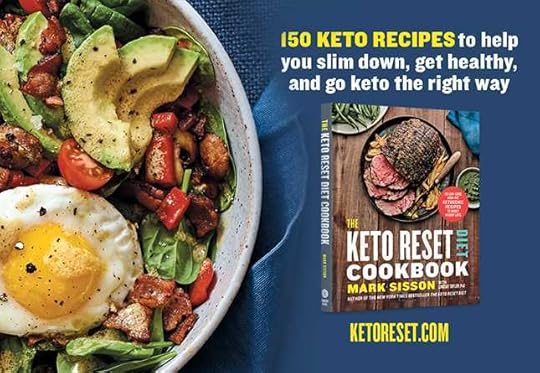Mark Sisson's Blog, page 126
October 25, 2018
Oxidative Priority: Dietary Fuels To the Body
 Today’s guest post is generously offered up by Craig Emmerich, husband to—and co-author with—the queen of keto herself, Maria Emmerich. Enjoy!
Today’s guest post is generously offered up by Craig Emmerich, husband to—and co-author with—the queen of keto herself, Maria Emmerich. Enjoy!
When we consume macro nutrients, our bodies go through a priority for dealing with them. This priority can be very useful in understanding how our bodies work and how to leverage it for losing weight.
The body doesn’t like having an oversaturation of fuel in the blood at any time. It tightly manages the fuels to avoid dangerous situations like hyperglycemia or blood glucose that is too high. But it also manages and controls other fuels like ketones (beta hydroxybutyrate or BHB levels) and fats (free fatty acids or FFA and triglycerides) to keep them under control and not oversaturate the blood with fuel.
It is like the engine of a car. You don’t want to give the engine too much fuel and blow it up. So the body controls the amount of fuels in the blood to ensure you don’t “blow up.” To do this, the body will address the most important (or potentially most dangerous) fuels first. It does this in a very logical way—in reverse order of storage capacity.
Here is a chart showing the breakdown of oxidative priority for dietary fuels.
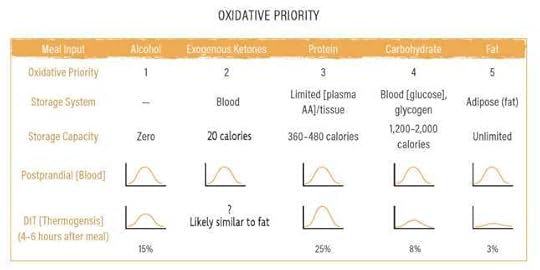
Modified Source: Keto. By Maria and Craig Emmerich
Original source: Oxidative Priority, Meal Frequency, and the Energy Economy of Food and Activity: Implications for Longevity, Obesity, and Cardiometabolic Disease, Sinclair, Bremer, et al, February 2017.
The #1 oxidative priority is alcohol because there is zero storage capacity for it. It makes sense that the body would address this first, since it can’t store it anywhere and too high blood alcohol means death.
The second oxidative priority is exogenous ketones. These are ketone salts that raise blood BHB levels. There isn’t a storage site for ketones either, so the body must deal with this before addressing other fuels. That is why exogenous ketones aren’t the best option when trying to lose weight. They displace fat oxidation, keeping fat stored while it uses the exogenous ketones as fuel instead.
The third oxidative priority is protein. Protein is a bit different, as there is a limited storage space for protein, but protein is not a good fuel source. It takes 5 ATP to turn protein into a fuel (glucose through gluconeogenesis) and another 2 ATP to burn in the mitochondria. Why would your body expend 7 ATP for something it can do for 2 ATP by just burning glucose or fat from your body? Protein is only really used as a fuel when other fuels (glucose and fat) are not present and it is forced to use protein. Protein gets preferentially used to stimulate muscle protein synthesis. It builds and repairs lean mass.
The next oxidative priority is carbohydrates. It has a moderate amount of storage capacity at 1,200 to 2,000 calories.
The last oxidative priority is fat. This makes sense, as there is a theoretically unlimited storage capacity for fat. There are people with upwards of 400 pounds of stored body fat, which represents 1.6 million calories.
Oxidative priority can help you understand what happens when you put certain fuels into your body. If you are drinking alcohol while eating carbs and fat, the carbs and fat will primarily go into storage while the body deals with the elevated alcohol.
To understand the power of oxidative priority take the case of an alcoholic. Alcoholics will have very low A1c levels (in the 4s) no matter what they eat! If they eat tons of carbohydrates they will still have an A1c in the 4s because the chronically elevated alcohol levels force the body to store all glucose while dealing with alcohol, creating a low A1c. I am not recommending anyone become an alcoholic to lower A1c level—but quite the opposite actually.
So, what does this mean, and how can you leverage your body’s biology to lose weight?

If you avoid alcohol and exogenous ketones, get a just enough protein to support maintenance of lean mass (about 0.8 times your lean mass in pounds for grams of protein a day), limit the carbs and then reduce dietary fat a bit to force the body to use more stored body fat for fuel you will lose body fat. When you restrict carbs for long enough (4-6 weeks for most people) the body gets used to using fat as its primary fuel (keto adapted). This means it can burn body fat or dietary fat equally well. Eliminating other fuels and keeping dietary fat moderate allows the body to focus on body fat for fuel resulting in fat loss.
That is our bodies system for processing fuels coming in through the diet. Leverage it for improved results and body recomposition.
Craig Emmerich graduated in Electrical Engineering and has always had a systems approach to his work. He followed his wife Maria into the nutrition field and has since dedicated his time researching and looking at nutrition and biology from a systems perspective. Over the last 8 years he has worked with hundreds of clients alongside Maria to help them heal their bodies and lose weight leveraging their biology to make it easy.
Thanks to Craig for today’s keto insights, and thanks to everybody here for stopping in.
You can follow Maria and Craig’s work on their website, Maria Mind Body Health, as well as their subscription site, Keto-Adapted, and their new keto courses.
Questions about dietary fuels and oxidative priority—or other points keto? Share them down below, and have a great end to the week. Take care, folks!

The post Oxidative Priority: Dietary Fuels To the Body appeared first on Mark's Daily Apple.



October 24, 2018
Mid-60s Check-in: 5 Ways My Workout Has Changed
 I’m 65, and though I’ve been able to stave off the worst of what normally passes for the “aging process”—as can almost anyone by paying attention to how you eat, sleep, train, move, and live—the fact remains that I’m not training like I used to.
I’m 65, and though I’ve been able to stave off the worst of what normally passes for the “aging process”—as can almost anyone by paying attention to how you eat, sleep, train, move, and live—the fact remains that I’m not training like I used to.
It’s not so much that I’m “losing” a step, although it happens to the best of us. It’s that I’ve totally transcended the need or desire to train hard for the sake of training hard. There are no more competitions. My ego is content on the training front. I’m not wrapped up in pounds lifted or miles run.
I get regular questions about what I do for workouts and how they’ve changed over time. Today I thought I’d answer this.
Miami has a fantastic gym culture with impressive facilities to support it. I almost have to go the gym. It’s something I still enjoy. I just make it count.
I’ve managed to compress my time in the gym with “super-sets” for each exercise.
These aren’t always super-sets where you’re bouncing between the squat rack and the bench press every other set. The kind of super-set I’m talking about is a rest-pause super-set. I try to hit between 12-20 total reps—that’s my goal—in three mini-sets with minimal rest. The super-set is broken up into three subsets with very short rest periods.
An example: Deadlift, 9 reps. Rest 30 seconds. Deadlift, 6 reps. Rest 30 seconds. Deadlift, 4 reps. You’re done. That’s a total of 19 reps. Once I hit 20, I’m adding weight.
Why I like this method:
Over fast. I get in, get a great workout, and get out.
No meandering and wasting time between sets. There are hard rules (30-second rests) that I must follow.
Hard to go heavy enough to hurt yourself. If you’re doing 15-20 reps with little rest, by necessity the weight you use needs to be manageable.
But heavy and intense enough to produce benefits. I know, I know, feeling sore the next day isn’t a good barometer of how effective the workout was. That’s what they say, but everyone secretly loves and craves the feeling of DOMS. Really makes you feel like you did something worthwhile.
I’ve fallen in love with the trap bar.
At this point in the game, I don’t need to hit PRs on the straight bar deadlift. Trap bars just feel safer, more natural, more versatile. Some great possibilities (many of which I throw in) include:
Trap Bar Deadlift With Squat Bias—Deadlifts with more knee flexion, almost a half squat.
Trap Bar Romanian Deadlift—Knees soft but mostly straight, almost a straight leg deadlift with or without touching the floor in between reps.
Trap Bar Power Shrug—Deadlift at a pretty good clip, explode upward and shrug the bar. Almost like you’re jumping without leaving the ground.
Trap Bar Squat—Squat down, grasp bar, stand up, repeat. Stack some weights and stand on them for added range of motion/squat depth.
Trap Bar Split Squat—Stand inside the hexagon, place foot on elevated surface (1.5 ft, about) behind you, perform a split squat, wake up sore.
Trap Bar Row—Stand inside the hexagon, bend over at the waist, row that bar up toward your belly.
The average person can get 90-95% of the benefits using a trap bar instead of a straight bar. Maybe higher, even.
I lift for a different purpose now.
As for the weights I use, now that my PR days are behind me, I lift to avoid injury now more than anything. That means knowing what “heavy” really is and backing down a hair. I’ll do one or two upper body days, and one leg day each week. That’s it. Two, maximum three strength sessions.
I base my workouts around standup paddling and Ultimate Frisbee games.
Both of these are stressful enough (in a good way) that I want to be rested for (and from) those activities before I engage in a lifting session. Just to be clear, I play Ultimate all-out for up to two hours, so it’s become my sprint day.
The Miami Ultimate Frisbee scene is very high-level. I’ve fallen in with a regular pickup squad, and the level of competition rivals Malibu’s. So, that aspect of my activity hasn’t changed. I’m still getting my one day of Ultimate a week.
If I’m feeling up to it, Miami beaches are fantastic for sprints. You don’t go as fast because the sand is so powdery, but it makes you work even harder.
Miami has also really changed how I spend time with my favorite activity, standup paddling.
In Malibu, it was a bit wilder. I’d head out past the breakers and paddle in any direction. It was huge, free, open, and infinite.
In Miami, you have the ocean side which is great and much calmer than Malibu, but you also have these inland waterways, like huge canals running through Miami. I’ve been spending a ton of time exploring them, checking out the beautiful homes and boats and even the occasional manatee popping up. And because it’s so calm, I can really go hard without worrying about waves. While paddling is fun, I go pretty hard for at least an hour and up to 90 minutes, so it’s a serious aerobic day for me.
I walk more.
I can walk so much more in Miami. In Malibu, I had to drive somewhere to walk, whether it was a trail head for a hike, down to the beach for a stroll, or to Venice or Santa Monica to just wander. In Miami, Carrie and I can walk out the door and go the market, the water, the book store, the cafe, or just wander. It’s integrated into our day, not something we have to schedule. People don’t really think of Miami as a ‘walking city,” and it’s certainly no New York or San Francisco, but it beats the pants off Southern California.
Trap bar, rest-pause sets, and environment aside, what I train hasn’t changed all that much. I’m still lifting heavy things, running really fast, moving frequently at a slow pace, and doing activities I love. But somehow I’m doing a better job of seamlessly integrating them into my daily existence. I’ve minimized the amount of time I spend lifting without compromising my results. I’m using my compressed training to fuel the activities I love doing, giving me more time that’s also higher quality.
A lot of this could be the simple result of moving somewhere new after living in the same city for twenty years, sort of a honeymoon phase. We’ll see. My workouts here are even more a part of my general lifestyle. They’re, for the most part, parts of my life rather than interruptions to it, which is the ancestral model at its modern best maybe. That’s how I choose to see it.
Thanks for stopping by today, folks. I’d love to read your feedback and questions and hear what new routines you’re trying out. Take care.

The post Mid-60s Check-in: 5 Ways My Workout Has Changed appeared first on Mark's Daily Apple.



October 23, 2018
Sheet Pan Dinners: Three Meals In 90 Minutes
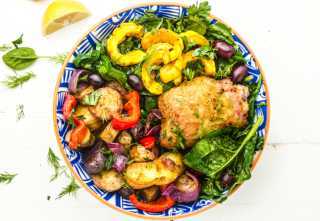 Putting dinner on the table just got easier with this meal prep plan that bangs out three dinners at once. All the mix-and-match ingredients you need for three different meals are cooked on single sheet pans, making cleanup easy, too.
Putting dinner on the table just got easier with this meal prep plan that bangs out three dinners at once. All the mix-and-match ingredients you need for three different meals are cooked on single sheet pans, making cleanup easy, too.
The cooked ingredients are simply seasoned with salt and pepper for maximum versatility. Add more varied flavors when you dish up by incorporating the suggested herbs, spices, dressings, and garnishes.
Each meal provides 4 servings. The food can be served at room temperature, reheated in a microwave, or reheated by sautéing the ingredients briefly in a pan with oil.
Primal Sheet Pan Dinners Menu
Chicken Fajita Bowl
Steak & Broccoli “Stir-fry”
Greek Chicken Plate
This menu is only a guide. Feel free to mix and match the ingredients with your tastes in mind.
Primal Sheet Pan Dinners Shopping List
Tools
3 half-size rimmed sheet pans (13”x18”)
Parchment paper or foil (for easier cleanup)
Spatula, for mixing ingredients while they cook
Food storage containers
Make-Ahead Ingredients
Avocado oil or extra virgin olive oil
Salt and pepper
8 skin-on, bone-in chicken thighs (This equals 1 chicken thigh per person/per meal. Add a few more chicken thighs for bigger appetites)
1 ½ to 2 pounds steak, about 1 inch thick (try flank steak, top sirloin steak, or strip steak)
1 pound small potatoes (about 2 inch-diameter) if desired
2 delicata squash
3 bell peppers
1 red onion
1 large bunch broccoli
8 ounces cherry tomatoes
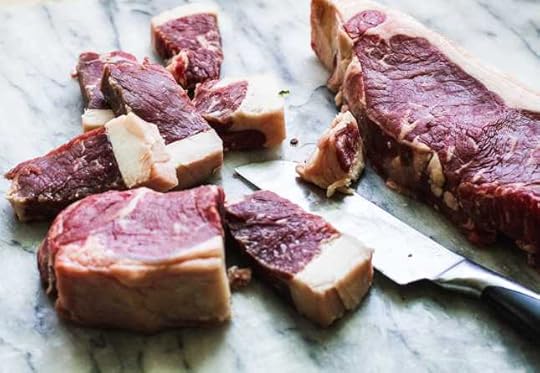
Fresh Foods, Garnishes & Flavor Enhancers
Cumin
Chili powder
1 bunch green onion
1 head of garlic
2 inches ginger root
2 avocados
2 5-ounce bags of baby spinach
1 bunch fresh cilantro
2 bunches fresh Greek herbs (choose from dill, parsley, mint, or oregano)
1 lime
1 lemon
1 container salsa
Toasted Nori or SeaSnax
1 jar kalamata olives
1 bag frozen cauliflower rice
Optional Enhancements From Our Own Primal Kitchen® Recipes and Products
Primal Kitchen Chipotle Lime Mayo
Primal Kitchen Greek Vinaigrette
Coconut Aminos
Primal Sheet Pan Dinner Plan
Time: Approximately 90 minutes
Heat oven to 425 ºF/218 ºC
Cover sheet pans with parchment paper or foil (optional). IMPORTANT NOTE: Parchment paper cannot go under a broiler. Do not use parchment paper under the steak when broiling.
Sheet Pan #1
Cut the small potatoes into ½-inch-thick rounds. Spread the potatoes out on a sheet pan. Lightly coat the potatoes with avocado oil.
Pat chicken thighs dry with paper towels. Arrange chicken thighs, skin side up, on the sheet pan with the potatoes. Set aside.

Sheet Pan #2
Cut the delicata squash in half lengthwise and scoop out the seeds, peel the red onion and cut in half, stem and seed the bell peppers. Cut all vegetables into 1/2-inch slices.
Spread the vegetables out on a sheet pan. Lightly coat with avocado oil. Set aside.

Sheet Pan #3
Cut the broccoli into florets. Spread broccoli florets out across one side of a sheet pan. Spread the cherry tomatoes out on the other side of the pan. Lightly coat everything with avocado oil. Set aside.
And finally…pat the steak dry with paper towels. Season generously with salt. Set aside on a plate.
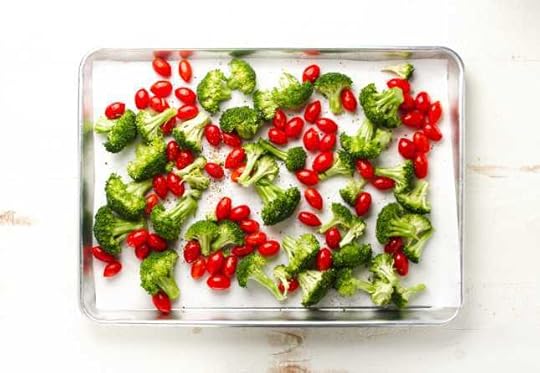
Cooking Instructions
Season the ingredients on all three of the sheet pans with salt and pepper.
Put all three of the sheet pans in the oven. Set the timer for 20 minutes. Gently mix and toss the vegetables once or twice while they cook.
After 20 minutes, remove the squash, onion, bell peppers, broccoli, and tomatoes from the oven. (If the vegetables aren’t cooked enough for your preference, they can stay in the oven a bit longer.)
Set the timer for 10 minutes, and continue to cook the chicken thighs 10 minutes more until the skin is browned and chicken is cooked through (165 °F).
While the chicken finishes cooking, scrape the vegetables off one of the sheet pans into a food storage container. Set the steak on this sheet pan. (NOTE: Parchment paper cannot go under a broiler. Remove parchment paper before broiling the steak.)
When the timer goes off, remove the chicken from the oven. Turn the broiler on to high.
Place the sheet pan with the steak on the top rack under the broiler. Broil the steak, flipping once, until the meat registers 135°F (medium-rare) and the meat is charred on the edges, about 4 to 5 minutes a side. Let the cooked steak rest outside the oven for 10 minutes before slicing it thinly against the grain.
Set food storage containers out on the counter. Separate the chicken and steak into containers. Store the potatoes in one container. Store the delicata squash, onion, and bell peppers in another container. Store the broccoli in one container and the tomatoes in another. All of these cooked ingredients will stay fresh in the refrigerator for 3 to 5 days.

Assembling the Meals
When you’re ready to eat, take out the containers and assemble a meal. You can assemble the ingredients into meals any way you like, but here are three ideas:
Meal #1: Chicken Fajita Bowls
Shredded chicken with roasted delicata squash, red onion, and bell peppers, plus avocado, green onion, salsa, cilantro, and a squeeze of lime
Shred the meat of four chicken thighs. Toss the meat with ¼ teaspoon cumin and chili powder. In each bowl, combine shredded chicken with half of the delicata squash, red onion, and roasted bell peppers.
Add garnishes: sliced avocado, green onion, salsa, cilantro, squeeze of lime
Add extra flavor: Thin Primal Kitchen Chipotle Lime Mayo with a few squeezes of lime juice until it has a slightly thinner consistency. Drizzle mayo on top.

Nutritional Information (per serving):
Calories—448
Net Carbs—17
Fat—26
Protein—28
Meal #2: Beef & Broccoli “Stir-fry”
Steak and broccoli over ginger and garlic cauliflower rice, garnished with green onions, toasted nori, and coconut aminos
In a saucepan, sauté a few finely chopped garlic cloves and a 2-inch piece of ginger root (peeled and cut into thin strips) in avocado oil until fragrant and lightly browned, 1 to 2 minutes.
Heat cauliflower rice according to package directions. Mix the garlic and ginger into the cauliflower rice, and portion into bowls. Top the cauliflower rice with sliced steak and broccoli.
Add garnishes: green onion, toasted nori (or Seasnax)
Add extra flavor: Drizzle coconut aminos on top

Nutritional Information:
Calories—360
Net Carbs—43
Fat—8
Protein—57
Meal #3 Greek Chicken
Chicken thighs with roasted potatoes, tomatoes, delicata squash, red onion, bell peppers, and sautéed garlic spinach with kalamata olives, fresh herbs, and a squeeze of lemon
On a plate, serve whole chicken thighs with the roasted potatoes, tomatoes, and leftover delicata squash, red onion, and bell peppers. Saute the bags of baby spinach in extra virgin olive oil with several cloves of minced garlic until the spinach wilts. Add spinach to the plates.
Add garnishes: chopped fresh parsley, dill, oregano, and/or mint, Kalamata olives, squeeze of lemon
Add extra flavor: Drizzle Primal Kitchen Greek Vinaigrette on top

Nutritional Information (without dressing):
Calories—465
Net Carb—34
Fat—22
Protein—26

The post Sheet Pan Dinners: Three Meals In 90 Minutes appeared first on Mark's Daily Apple.



October 22, 2018
Dear Mark: Is There No Upper Limit to Endurance Training?
 Yesterday, I linked to a study showing that the beneficial effects of high levels of cardiorespiratory fitness—the kind you build with cardio/endurance training, HIIT, and sprints—have no upper limit. At first glance, this study appears to bust the “myth” of chronic cardio and the U-shaped curve of endurance training and prove that the more you train, the longer you’ll live. This appears to run counter to some of my central claims—that too much mid-to-high intensity endurance exercise leads to burnout, health issues, and diminishing returns.
Yesterday, I linked to a study showing that the beneficial effects of high levels of cardiorespiratory fitness—the kind you build with cardio/endurance training, HIIT, and sprints—have no upper limit. At first glance, this study appears to bust the “myth” of chronic cardio and the U-shaped curve of endurance training and prove that the more you train, the longer you’ll live. This appears to run counter to some of my central claims—that too much mid-to-high intensity endurance exercise leads to burnout, health issues, and diminishing returns.
A commenter wrote a great comment that got me wondering:
As far as “the more exercise the better” study I wonder if folks who had to drop out of long distance cardio training due to injuries or cortisol driven exhaustion are considered in the equation? In other words, if you can tolerate chronic cardio you may live longer, otherwise it might break you down. Everyone has a sweet spot for exercising is my gut feeling and you have to “listen to your body”. I still like the primal mantra along the lines of (if I may be so presumptuous as to paraphrase Mark) “walk a lot, do sprints once a week, lift heavy things once or twice a week, spend time outdoors, take part in sports or recreational activities that are fun for you”.
What do I think is going on? How do the results of this paper jibe with my take on Chronic Cardio?
First off, we have to acknowledge the basic structure of the study.
This study didn’t actually measure “hours spent training.” They gave subjects treadmill tests (stress tests) to determine their cardiovascular fitness, then divided everyone into different tiers of fitness based on the results. In fact, the authors of the study criticized the shortcomings of previous studies which used self-reported training data instead of objective measurements of cardiorespiratory fitness like the treadmill test. This makes the study far more accurate and useful. It also means you can’t make any ironclad proclamations about the connections between hours spent training and longevity. You can certainly make inferences—people who had better cardio fitness probably spent more time training to get it—but there are other interpretations. All you can say for certain is that higher levels of cardio fitness predict greater longevity.
I don’t see how anyone could argue with that. Of course being fitter is better.
But my criticism of chronic cardio isn’t a criticism of cardiovascular fitness. It’s a criticism of how most people go around obtaining that fitness—by destroying their bodies.
That doesn’t have to happen anymore. Tons of top guys these days are finally figuring out that you don’t have to log as many laps/miles/etc as possible to maximize your performance, but that wasn’t always the case. I grew up convinced that the more miles I ran, the healthier I’d be. That’s how I did it back in my marathon and triathlon days, and it almost destroyed me and an entire generation of my peers.
You can train twice as much as the next guy yet have worse fitness, either because you’re not training intelligently, you’re overtraining and hampering the adaptive process, or you’re not sleeping. That’s chronic cardio. You can train less and get better results, if you’re optimizing your recovery, nutrition, and sleep. That’s Primal Endurance.
As for these subjects, there is some serious genetic confounding occurring. Those dudes with elite fitness levels well into their 70s are often a different breed. They’re hard to kill. They’re tough. They can withstand the discomfort of grueling mile after mile. What other types of discomfort can they bear and even grow from? They’re just more robust than the average 70-year-old. It may not be the elite training itself that’s making them resist death. It’s just as likely they have the genetic capacity to excel in endurance training, and even if they didn’t exercise they’d still live longer than average.
There’s also the healthy user bias. The kind of lifestyle regular exercisers follow emphasizes sleep, plenty of rest and recuperation, smart supplementation and nutrition, and all sorts of other things that are also linked to longer, better health.
This paper makes a strong case for using something like Primal Endurance to build great cardiorespiratory fitness without risking chronic cardio territory.
Thanks for writing and reading, folks. Take care!

The post Dear Mark: Is There No Upper Limit to Endurance Training? appeared first on Mark's Daily Apple.



October 21, 2018
Weekend Link Love — Edition 526

Research of the Week
A low-carb, high-fat diet improves glucose control and lowers fasting insulin in people with Type 2 diabetes, whether they walk after meals or not.
Many cases of dementia may come down to non-inherited random errors during DNA replication.
An active commute through natural settings is a reliable recipe for good mental health.
Human neurons are uniquely powerful and self-contained.
Blue light is more disruptive to sleep when viewing emotionally salient material.
New Primal Blueprint Podcasts

Episode 283: Jolene Goring: Host Elle Russ chats with Jolene Goring about the powerful effects of systemic enzymes.
Each week, select Mark’s Daily Apple blog posts are prepared as Primal Blueprint Podcasts. Need to catch up on reading, but don’t have the time? Prefer to listen to articles while on the go? Check out the new blog post podcasts below, and subscribe to the Primal Blueprint Podcast here so you never miss an episode.
Interesting Blog Posts
How to raise less materialistic kids.
Music makes living through conflict bearable.
Media, Schmedia
Nebraska school cook serves kangaroo chili, gets bounced from job.
The implications of consumer gene tests are always changing.
Everything Else
Chinese city to launch a fake moon with a “dusk-like glow” to replace streetlights.
Why didn’t ancient literature discuss “feelings”?
Humans are unique in our ability to produce ketones.
Things I’m Up to and Interested In
Videos I’m loving: The videos from the 2018 Ancestral Health Symposium are live!
Study I’ll have to take a closer look at: The more exercise, the better.
This is another reason why I love entrepreneurship: Entrepreneurs may have saved the bees.
Study I’m, well, studying: High cholesterol in keto-adapted athletes.
I’m not surprised: The World Health Organization ignored two major studies into the health effects of meat when writing its analysis of meat’s dangers.
Recipe Corner
Another great air fryer recipe: bacon Brussels sprouts.
Sometimes you just want a casserole. Here’s a great green bean one.
Time Capsule
One year ago (Oct 14–Oct 20)
The Lowdown on Keto Side Effects: What’s Real, What’s Not, and What’s Helpful? – How to parse it all.
Gender Bias in Health Research: How It Operates and Why It Matters – See more clearly.
Comment of the Week
“More great ‘anti-hype’ from Mark Sisson!”
– Thanks, Philip May. Nice description of what I try to do.
Want to make fat loss easier?
Try the Definitive Guide for Troubleshooting Weight Loss for free here.
The post Weekend Link Love — Edition 526 appeared first on Mark's Daily Apple.



October 20, 2018
Primal Peanut Butter Cups
 With Halloween just around the corner, we couldn’t let the occasion go by without sharing a Primal treat for good fun. While we’re not promoting the usual sugar spree, a little something can feel festive especially if you’re playing host.
With Halloween just around the corner, we couldn’t let the occasion go by without sharing a Primal treat for good fun. While we’re not promoting the usual sugar spree, a little something can feel festive especially if you’re playing host.
These nut butter cups deliver on richness (and sweetness) and offer a more natural alternative to the packaged, preservative-filled candies most will get in their pumpkins that night. Gather the little ghosts and ghouls to help you in the kitchen. This recipe is easy, fast, and family-friendly.
Note: You can substitute almond butter for the peanut butter used in this recipe, and it will turn out great—just as delicious!
Servings: 24 cups
Time In the Kitchen: 20 minutes
Ingredients:

½ cup smooth organic peanut butter or almond butter
3 tablespoons coconut oil, divided
2 tablespoons coconut flour
2 tablespoons raw honey
¼ teaspoon vanilla extract
15 ounces dark (60%) chocolate chips or bar (chopped finely)
Instructions:

Add the nut butter, 2 tablespoons coconut oil, coconut flour, honey, and vanilla extract to a food processor or blender and mix until combined, stopping to scrape the sides and blending again. Set mix aside. Melt the chocolate with 1 tablespoon of coconut oil over a double boiler on low heat.

Line a 24-cup mini muffin tin with paper cups, or use a silicone mini muffin container. Spoon a teaspoon full of melted chocolate into the bottom of each cup. Spoon a tablespoon of nut butter on top of each cup.
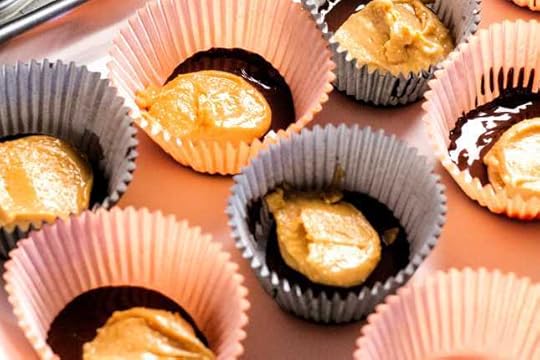
Cover nut butter evenly with the remaining melted chocolate. Chill until firm, about 2 hours. Store in a covered, cool and dry place.

Nutritional Information (per serving):
Calories: 283
Carbohydrate: 10 grams
Protein: 2 grams
Fat: 10 grams

The post Primal Peanut Butter Cups appeared first on Mark's Daily Apple.



October 19, 2018
From Bedridden to Radiance: How I Used a Holistic Lifestyle to Heal From a Near-Death Accident
It’s Friday, everyone! And that means another Primal Blueprint Real Life Story from a Mark’s Daily Apple reader. If you have your own success story and would like to share it with me and the Mark’s Daily Apple community please contact me here. I’ll continue to publish these each Friday as long as they keep coming in. Thank you for reading!
 We live in a stress-filled world. Poor quality nutrition, toxic chemicals, xenoestrogens, EMFs, blue-light, deadlines, and traffic have us competing for our health. But on March 20, 2011, life got much more stressful than I could have ever imagined.
We live in a stress-filled world. Poor quality nutrition, toxic chemicals, xenoestrogens, EMFs, blue-light, deadlines, and traffic have us competing for our health. But on March 20, 2011, life got much more stressful than I could have ever imagined.
That particular day, I found myself in an ICU bed after recently being hit by a series of large vehicles. I recalled crossing a busy street in Traffic Nation, a.k.a. Los Angeles, where I was unexpectedly hit by a Land Rover headed west. The force of the blow threw me into the eastbound lane, where I was then run over by a Toyota Tundra. Needless to say, my world was rocked.
Lying unconscious in the middle of Melrose, paramedics and first responders aided my broken body. Upon impact I had seven broken ribs, a collapsed lung and “the worst compound fracture’ the maxillofacial specialist at the hospital had ever seen…BUT I was still alive. Perspective.
For any person, this would be a traumatic experience, but for a young, 30-year-old working actor and model, my future was suddenly completely unsure. At this time, my physical appearance was a huge part of my livelihood, and quite honestly, I wasn’t certain I would ever look the same.
My body wrecked and my confidence not far behind, I found a silver lining by focusing on what I DID have rather than what I didn’t. Some say true purpose is born from tragedy, and luckily for me, this was the case. As easy as it would have been to give up, my near-fatal accident turned out to be the ultimate blessing in disguise — that experience sparked the fire in my soul’s purpose. I set forward with passion to recover my health and to get back in better shape than I was before the accident. Along the way, I shared everything I had learned about nutrition, natural healing, skincare and how to feel better about the reflection in the mirror with the rest of the world.
All Natural Recovery
My recovery wasn’t easy, physically or mentally. I had pain from head to toe, my jaw wired shut and nubs for front teeth, I felt myself turning into a zombie from the antibiotics, CT scan and monthly x-rays. It was dark. I lost my zest as a human being. I definitely wasn’t my ‘happy-go-lucky’ self, and it is a scary thing to witness yourself changing for the worse as a person. But I didn’t give in to that feeling, I quickly decided I was going to do everything in my power to ‘beat’ this funk that I was in and recover as quick as I could, as best as I could. A walking ball of inflammation, I began researching ingredients for how I was going to accelerate my healing both internally and externally. I met with several Chinese herbalists and developed a morning tonic that would help build my blood, assist in ridding my body of toxins and provide the best nutrition possible while not being able to chew food. It was extremely tough. Deer Placenta, egg yolks, bison liver… You name it, I tried it. I just wanted to get back to the old me!
In addition to this, my face was extremely swollen, covered in abrasions, and I had an unsightly deep scar on the left side of my face from point of impact that really was an eyesore. Social situations were uncomfortable, so I spent most of my time in my little apartment researching. Unhappy with the toxic, paraben-laced products that my doctors were recommending that I use to heal my skin, I began obsessive research into creating my own remedy. My simple understanding of the negative side effects of the medical and conventional led me into an ever-evolving journey of education of ingredient decks. I learned a lot about the physiology of toxic fragrances, artificial colors and other synthetic chemicals.
It turns out, most conventional skin-care products were going to do more harm than good for my skin. Parabens, one of the more common ingredients, is estrogenic and antagonistic to androgen production, meaning they interfere with the endocrine system’s ability to produce and regulate hormones—this physiological mechanism makes them correlated with breast and other cancers. This sort of research only further validated my protest against the recommended creams and further fueled my desire to heal my body, naturally. I understood that the skin pores are vulnerable to everything they are exposed to, so I only use products that are free of any known toxic, carcinogenic, inflammatory substances. I also ensured that every ingredient that touched my skin came with beneficial, therapeutic effects for my skin cells. I deeply felt that my skin would respond best to a blend of nutrient dense organic ingredients, clays, superfood extracts, cold pressed essential oils and butters.
Researching and finding these hidden gem ingredients became my own little creative outlet! I would isolate certain ingredients and note their effect on my skin, I would pay close attention to the activity of the ingredients and the synergy that they created together. What started as a carefully formulated blend of clays sourced from all over the world, quickly turned into a mineral rich, superfood regenerative meal for the skin on my face. Not only did it help reduce the swelling, and completely heal the abrasions on my face, but my complexion was crystal clear and silky soft. I knew I had something special. The same people that saw me in an ICU bed were blown away by what they saw just a few weeks later. Wondering what I did to heal so quickly, I drove all around town with my backpack, wooden spoon and bowl and would mix up a mask for them to try.

Blown away by the feedback, I knew I had something special. The Alitura Clay Mask was born! Next thing you know I’m melting down cacao butter in a cast iron pan in my kitchen, combining it with Manuka Honey, adding Sea Buckthorn Oil and other skin healthy botanical extracts…. And the best part…seeing and feeling results! The concoction made out of that cast iron pan became my Alitura Night Cream. It was great because I really became my own biggest science experiment. The cell turnover process was sped up by staying extremely consistent with a routine of using the Clay Mask which exfoliated dead skin, then following with the cream that I was making to heal, hydrate and deeply nourish the freshly exfoliated skin’s surface. I started to look forward to doing it.
Just 2 1/2 months after a life threatening accident, I was back on the runway, modeling for Macy’s! My first victory in my recovery.
 Shortly after that, Bulletproof CEO Dave Asprey heard about what I was doing and had me on his top ranked podcast ‘Bulletproof Radio.’ Our podcast got such a response from it that he invested in me and my brand and the rest is history. Four years after launching the business out of a dingy studio apartment in North Hollywood, California, Alitura Naturals now has 20 products and is in 76 countries. Alitura is Latin for ‘feeding and nourishing,’ and we maintain that in our core brand mission and ingredient integrity in every product that we make.
Shortly after that, Bulletproof CEO Dave Asprey heard about what I was doing and had me on his top ranked podcast ‘Bulletproof Radio.’ Our podcast got such a response from it that he invested in me and my brand and the rest is history. Four years after launching the business out of a dingy studio apartment in North Hollywood, California, Alitura Naturals now has 20 products and is in 76 countries. Alitura is Latin for ‘feeding and nourishing,’ and we maintain that in our core brand mission and ingredient integrity in every product that we make.
I specifically want to say thank you to Mark Sisson and the extremely kind staff at Primal Blueprint, Primal Kitchen® and Mark’s Daily Apple. The first book that I ever read in the health and wellness space was The Primal Blueprint. From cover to cover, I found myself devouring information in that book and implementing it into my and my family’s lives. That book flat out changed my life, and was the catalyst in leading me towards an enriched quality of life by keeping me on a path towards my ultimate purpose.
It truly is an honor to contribute on a blog that I have read and been a fan of for years. Thank you!
— Andy Hnilo, CEO & Founder, Alitura Naturals
Twitter, Instagram and Facebook
Folks, I hope you enjoyed Andy’s story as much as I have. I’m happy to share that Andy’s offering Mark’s Daily Apple folks a generous discount. Check out his product line and use the coupon code “primal” (of course) to receive 20% off anything in the entire store—and enjoy free U.S. shipping, too.
Be sure to catch Andy on this coming Monday’s Primal Blueprint Podcast (10/22/18). Our own Elle Russ chats with Andy about his near death experience, his commitment to full recovery, and the thriving business that came out of his resolve.
Have an awesome weekend, everyone.

The post From Bedridden to Radiance: How I Used a Holistic Lifestyle to Heal From a Near-Death Accident appeared first on Mark's Daily Apple.



October 18, 2018
How To Cure Plantar Fasciitis
 As many of you know, Brad is my longtime writing partner, host of the Primal Endurance podcast and host of the weekly keto show on the Primal Blueprint podcast. Our relationship goes back 30 years to when I was Brad’s coach during his career on the professional triathlon circuit. The start of Brad’s chronic plantar fasciitis ordeal dates back nearly that long, until he was completely cured in a matter of weeks back in 2011. Hence, the subject of today’s post! If you are a sufferer, pay close attention because we dove deep into this topic and are giving you the tools to never suffer again.
As many of you know, Brad is my longtime writing partner, host of the Primal Endurance podcast and host of the weekly keto show on the Primal Blueprint podcast. Our relationship goes back 30 years to when I was Brad’s coach during his career on the professional triathlon circuit. The start of Brad’s chronic plantar fasciitis ordeal dates back nearly that long, until he was completely cured in a matter of weeks back in 2011. Hence, the subject of today’s post! If you are a sufferer, pay close attention because we dove deep into this topic and are giving you the tools to never suffer again.
Indeed, as Brad will detail shortly, miracle cures are possible, even for extreme sufferers. About three years ago, Brad was over at my place on a Monday and noticed me spending a lot of time rubbing and stretching my chronically tight Achilles tendon; it had taken its weekly beating the previous day at Ultimate Frisbee. I tried the prolonged stretches he details in the article and experienced immediate relief. (Around the same time, I also started to experiment with the early supplemental collagen products on the market, which also helped my foot issues and other joint aches and pains clear up.).
Enjoy today’s article, and let us know your thoughts on this treatment protocol.
Plantar fasciitis—it’s painful to even pronounce, and if you contract this condition you’re in for a long, frustrating, painful ordeal. It’s characterized by a burning sensation around the rim and/or bottom of your heel, and assorted peripheral pains such as a sore or burning arch, sensitive nerve endings along your arch, inflamed bursa sacs in your heel bone that make the heel sensitive to touch and applied weight, a bumpy, lumpy sensation on the bottom of your heel that are often called bone spurs, and general stiffness, tightness, and pain in the foot, arch, Achilles tendon, and calf muscles.
Symptoms are typically worse first thing in the morning or after prolonged periods of sitting or standing. If you have a mild case, you can get some range of motion and blood flow going upon awakening and the pain will typically subside and not compromise your exercise. In advanced stages, you will have a hard time getting mobility going and even walking will be painful. When you do get sufficiently warmed up and into a workout, the burning pain will often continue during and after exercise. The condition can worsen over time until you are sidelined by the lack of mobility and subsequent chronic pain.
Explaining Plantar Fasciitis: Anatomy and Causes Behind It
The plantar fascia is a super-strong ligament that runs the length of the bottom of your foot. On one end, the plantar fascia attaches to the metatarsal bones of each of your toes. It then fans out wide, like a sheet covering the length of the bottom of your foot. It subsequently tapers to attach into your calcaneus (heel bone). The plantar fascia acts as a prominent shock absorber when you walk, run, or jump. Consequently, it gets put under a lot of stress and can easily become inflamed when the muscles, ligaments, and tendons in your lower extremities are dysfunctional or overstressed.
Plantar fasciitis is extremely common among not only runners and competitive athletes but also folks who work on their feet all day like nurses, laborers and even standup desk user. Then there are people who have strong sedentary patterns (commute, desk job, insufficient exercise); people with arthritis, obesity, poor muscle tone, flexibility, mobility or generally poor physical fitness; and people who wear crappy modern shoes with stiff construction, encased toe compartments, and elevated heels. Does that pretty much cover the entire population of the developed world?
Indeed, no one is immune to the risk of plantar fasciitis, because the condition often comes about when there is any sort of weakness, overuse, inflammation, or dysfunction in the muscles, tendons, and ligaments in the lower extremities. For example, if your calf muscles or Achilles tendons become stiff and inflamed from doing chronic cardio or consuming an inflammation-boosting high-carb, allergenic-loaded, SAD diet, these dysfunctions may manifest most painfully as plantar fasciitis.
I don’t know many serious runners who haven’t had this condition at one point or another in their lives. I had the condition for the better part of 15 years—ranging from a mild lingering annoyance that vanished with some quick morning exercises that increased blood flow and mobility, to so debilitating that I couldn’t walk in the morning. Indeed, for several years in the midst of my professional triathlon career, I had to exit bed onto one leg, hop out the door into the backyard, then drop my right leg into my backyard spa. Only after a few minutes of working through ankle and calf range of motion with hot jets blasting could I apply pressure to the foot and walk normally. Then, I’d lace up my shoes and head out for a run of five, ten, or even twenty miles!
That’s a strange juxtaposition from cripple to endurance machine in a few minutes, but it generates an important reflection: plantar fasciitis almost never gets better with rest alone. On the contrary, it quite often gets worse when an injured athlete stops running or a nurse takes a leave from the ER floor for a desk position. For example, during one off season of my professional career, I decided (in consultation with my coach Mark Sisson) to take a six-week break from running in order to focus on swimming and cycling and allow the painful plantar fasciitis injury to heal once and for all. Upon my return to light jogging, you can guess what happened: the injury was more painful than ever!
Interventions That Address the Symptoms, Not the Cause
Before we get to the prescribed treatment protocol, let’s look at what interventions are commonly suggested but generally don’t work well at actually treating the condition. (See how many look familiar.) As you might expect, athletes and active folks have tried all sorts of treatment modalities and remedies, most of them landing somewhere on the spectrum from ineffective but harmless to outright disastrous.
Rest
Well intentioned as it may be, rest is usually ineffective with plantar fasciitis. Getting off your feet or out of your exercise groove results in atrophy of both the large muscles and small stabilizer muscles in your legs as well as reduced range of motion, increased stiffness, shortened muscle, and—often—more pain when you try to return to your normal activities.
Orthotics, Arch Supports, Arch Taping
These approaches work like a Band-Aid works to stop the bleeding. If you have plantar fasciitis and have to perform for your country in the Olympics, a professional taping job is a great idea to keep the pain at bay and allow you to qualify out of your heat for the quarter-final. Alas, these support measures fail to address the cause, however.
Furthermore, they can very often compromise healing if you insist on using them long-term instead of making a sincere commitment to addressing and healing the underlying causes. Specifically, using artificial aids and supports will cause weakening and atrophy of the lower extremities over time. You make things easy for your feet, so they can wither away inside a cushy protective cocoon instead of be challenged to grow stronger every moment that you ambulate.
That said, remember that staying active is essential to ultimate healing of plantar fasciitis, and so using support measures to help you stay active by any means necessary can be warranted over the short term.
Ice, Heat, Electrical Stimulation, Ultrasound
These and other feel-good techniques are generally focused on relieving painful symptoms—symptoms that are bound to return again and again over time until you address the cause. As previously stated, complementary therapies are fine to the extent that they help keep you active. Ice massage can also be helpful in the aftermath of performing some aggressive healing exercises, as we will discuss shortly.
Massage Therapy
This can be highly effective to undo some of the damage caused by chronic injury and facilitate healing. In particular, Active Release Technique (ART) and deep tissue techniques go a long way toward increasing the mobility and fluidity of muscles and connective tissue.
The caveat here is that deep massage and ART treatments set you up for success, but you have to do the healing work described shortly to make the effects stick. Otherwise, you will undo damage with the bodywork, then create the damage all over again by exercising on dysfunctional legs.
Cortisone Injection
Can you say “rupture”? Not rapture, but rupture. Yes, ouch! Generally, cortisone injections provide immediate and amazing relief from pain symptoms, often at extreme risk to your long-term health. When you override your body’s natural inflammatory processes and pain signaling with a powerful drug, you gain instant relief, but increase injury risk because you no longer are governed by natural tightness and pain that is attempting to protect you from the damage of performing with a dysfunctional appendage. Furthermore, anti-inflammatory treatments (including chronic use of seemingly innocent NSAIDS before workouts) weaken your natural ability to regulate inflammation over time.
There are a tiny fraction of injury cases where a cortisone injection may provide enough relief to facilitate an aggressive rehabilitation process that results in healing, but I urge extreme caution here. I say “extreme” because you may face enthusiastic health care professionals who will pretty much beg you to accept an injection. I know someone whose decades long nursing career ended in large part due to a cortisone injection that preceded a rupture, multiple surgeries, and ultimately a downward spiral that ended in permanent disability status.
The Plantar Fasciitis Cure: An Extended Stretching Regimen For Fast Healing
When you address the causes of plantar fasciitis, you’ll experience relief from the painful symptoms surprisingly quickly. To correct the cause, you must lengthen your calf muscles, increase mobility throughout the lower extremities, and start a methodical progression to a more minimalist/barefoot lifestyle. Commit to the following protocol every single day for just a couple weeks and it’s quite likely that even a severe and debilitating long-term condition will clear up to the extent that you will be pain-free and fully functional in a matter of weeks.
Lengthen Your Calf Muscles
“Do the wall stretches several times a day. Hold each stretch for two minutes. You’ll be healed in a few weeks.” This brief quip was all I needed to cure 15 years of consistent pain and suffering from plantar fasciitis. The message was delivered to me in 2011 by a podiatrist in a booth at the race expo of the Sacramento, CA, Urban Cow Half-Marathon and 5k—where I am the announcer annually. I have tried in vain to figure out who the guy was, but I’ll extend my deepest gratitude to the mystery healer right here and now.
Here is what happened on that fateful day: I typically walk the grounds and meet the exhibitors, so I can give them a little plug over the P.A. I remember from that day a booth with signs about healing foot pain and exam tables set up for interested runners. An enthusiastic podiatrist greeted me at the booth and started talking about how he could easily and quickly cure conditions like plantar fasciitis.
I challenged his assertion, informing him that I’d had the condition for 15 years and had tried everything: morning Jacuzzi hopping, a heel lift in my right foot, removing the heel lift, returning the heel lift, expensive rigid orthotics custom molded from my footprint, expensive soft “dynamic” orthotics made of silicone gel, obsessive icing and stretching, wearing giant pillow cushion shoes from Nike, switching over to Vibram Five Fingers and other minimalist options, switching back to pillow shoes—basically everything short of the dreaded cortisone injection.
I eventually agreed to try the prolonged stretches, obviously with huge reservations but a sincere commitment. In a few weeks, my symptoms were completely gone for the first time in 15 years. I’d call it a miracle, but it was so incredibly simple I’m not sure you can call it a miracle.
Extended Wall Stretch
Hopefully, you’re familiar with the wall stretch that is the runner’s bread and butter? You extend one leg behind you, lean into the wall at a 45-degree angle, and push against it like you are trying to push it over. With your rear leg straightened and heel grounded, the stretch focuses on the soleus, the narrow muscle running along either side of your leg and merging at the bottom into your Achilles tendon. When you bend your rear leg and lift your heel off the ground, you redirect the emphasis to the gastrocnemius, the ball-shaped muscle that gives you that sexy rock-hard definition on the upper part of your leg.
Holding each of the aforementioned four stretches (left leg straight, left leg bent, right leg straight, right leg bent) for two minutes is the secret to healing. In case you’ve never timed your stretches, holding a single position for two minutes will likely seem like an eternity. I’d speculate that the most devoted stretching enthusiasts might never hold a single stretch for than 10-20 seconds. Even the most deliberate of yoga classes won’t hold you in a single position for that long. As I mentioned, I had devotedly stretched my lower legs and feet in assorted ways for years in the tug-of-war against my condition, but never held any single stretch for so long.
Why Two Minutes?
When you hold a stretch for two minutes, you are sending a powerful message to your musculoskeletal and central nervous systems to lengthen the relevant muscle fibers. Witness ballerina dancers stretching for hours every day in order to maintain optimal muscle function for their demanding efforts—constantly reinforcing the message to brain and tissue that they need to by hyper-flexible.
This process of lengthening a muscle is complex but important to understand. If you listen to or read the Nutritious Movement commentary from noted biomechanist and author Katy Bowman, you may be familiar with the term proprioceptors. These are the nerve endings that help your muscles communicate with your central nervous system. When your proprioceptors detect a muscle fiber being stretched, something called the stretch reflex is triggered. This reflex causes a stretched muscle to contract—an excellent safeguard against injury during assorted day-to-day activities, including fitness activities and sports.
After a workout in which muscles have repeatedly contracted or absorbed impact, holding a few stretches for twenty seconds will send a nice little message to the fibers to relax and loosen up a bit as you transition from a state of exertion to relaxation. Then the stretch reflex kicks in, you experience a little discomfort, and end the stretch. When you go big time, work through the possibly uncomfortable stretch reflex sensation, and hold the muscle in a stretched position, you start to make some real progress. Here the proprioceptors in the stretched muscle, known as the muscle spindles, become habituated to the new length of the muscle such that the stretch reflex is muted. Instead, when specific thresholds of stretching frequency, intensity and duration are exceeded, a lengthening reaction occurs in the muscle. Here the muscles relax and allow you to deepen into the stretch. If you have ever been to a yoga class and noticed you can take stretches much deeper after you are warmed up and habituated with repeated stretches, you may know what this lengthening reaction feels like.
When your muscles relax due to the lengthening reaction, another key player on your healing team jumps into action: the golgi tendon organ. This is located in the tendon near the end of a muscle. It sends a message to your central nervous system, essentially: “Hey, this dude is sick of suffering with plantar fasciitis for 17 years. He wants some longer calf muscles for Christmas, so please comply.” Enjoy this much more detailed and scientific discussion of the science of muscle stretching.
Tips For Adopting the Healing Protocol
If you want to heal quickly, strive to quickly work up to doing the wall stretch protocol several times a day (shoot for five times or more). As described previously, this will take all of eight minutes per session: two stretches on two legs for two minutes each. An aggressive stretching regimen will, in a matter of days, greatly relieve the stress on your arch and heel caused in large part by shortened muscles that don’t absorb impact optimally.
Because of the high degree of difficulty with two-minute stretches, you can expect some next day soreness. Take care to stretch only the point of mild discomfort instead of actual pain. This may mean you have to back off a bit during your wall push to survive until the two-minute bell. You will also likely discover that you will be able to hold a much deeper stretch in the evening than in the morning, and more easily reach the two-minute bell. Alas, doing these stretches first thing in the morning when your muscles are the shortest is critical to your progress. So is doing them as many times per day as you are willing. Remember, we are trying to work beyond the stretch reflex and achieve a lengthening reaction.
You may even consider getting the legendary Strassburg sock to assist your healing process. This device, a sock with a strap attached, places your ankle in a flexed position all night, putting the plantar fascia under tension so that it does not contract and cause the painful morning stiffness. Instead, you wake up with an elongated plantar fascia much like the afternoon version that feels much better to walk on than the morning version. Again, the sock is best used in conjunction with an aggressive healing protocol.
Please keep in mind this prolonged stretching protocol is designed for injury prevention/healing, and is not advisable right before a workout. You may have heard prominent accounts of how static stretching can temporarily weaken a muscle for up to 30 minutes, and this is a valid concept. After all, you are about to demand intense contractions from your muscles for the workout, so aggressive pre-workout stretching is not the best way to prime them for action. Instead, do a simple warmup—increasing body temperature and respiration to the extent that you break a little sweat.
Watch this video where I describe the power of the wall stretch to heal plantar fasciitis and direct you to do the stretches correctly.
Mobilizing Lower Extremities
Concurrent with your commitment to prolonged calf stretches is a commitment to achieve increased mobility and flexibility in the foot and leg, via a series of special movements and treatment modalities with colorful nicknames. If you’re in the Crossfit scene or otherwise a fan of Dr. Kelly Starrett, aka “K-Starr,” you might be familiar with some of the unique and colorful terminology—terms like bashing, tacking and mobilizing—that have become his custom lexicon and spread like wildfire into the fitness community. K-Starr is a former elite level whitewater kayak athlete, proprietor of San Francisco CrossFit, creator of the popular MobilityWOD.com website, and author of Becoming a Supple Leopard—perhaps the most comprehensive volume on mobility, flexibility, functionality, healing and prevention for athletic folks ever in the history of the world. Visit MobilityWOD.com to get a free 10-day dose of Kelly and his highly engaging, informal, and humorous style with which he conveys his unique and effective approach.
K-Starr is a big fan of using toys like massage balls, golf balls, lacrosse balls, foam rollers, voodoo straps (try this Voodoo Floss treatment for plantar fasciitis) and even elbows in an aggressive and focused manner to increase blood flow, improve range of motion, and facilitate healing in muscles and connective tissue. Once your mobility improves, you then have a fighting chance at exhibiting correct functional movement during exercise and daily life (e.g., running with a balanced center of gravity over your feet and an efficient dorsiflexion of the foot on each stride), such that you won’t be doomed to a lifetime of repeating injuries, both acute and overuse.
Regarding plantar fasciitis, Starrett recommends attacking the cause by working to increase mobility, flexibility, and functionality throughout the lower extremities. You can check out his full suggested regimen on YouTube.
Complete the prolonged stretching plus mobility work protocol several times a day until the pain and stiffness are nearly when you awaken in the morning. Then you can shift into maintenance mode where you might do the stretches once or twice a day instead of five to seven times a day. And you might do your bashing, tacking and mobilizing only in the aftermath of tough workouts when you experience next-day stiffness.
Your main objective is to prevent the shortening and lost mobility that laid the foundation for plantar fasciitis in the first place.
Look for Brad’s follow-up post on preventing plantar fasciitis from setting in (or re-occurring) later in just a couple weeks. In the meantime, give your focus to the treatment, and let these stretches do their magic. Thanks again to my friend, Brad Kearns, for stopping in and sharing his experience today.
Again, you can follow Brad on his new podcast, Get Over Yourself, where he gets to unleash his lively personality and cover broader topics including health, fitness, peak performance, personal growth, relationships, happiness, and longevity, always with humor and a little spice.
Thanks, everybody. Be sure to share your thoughts and questions on plantar fasciitis below. Have a great end to your week.
Resources/References:
Dr. Phil Maffetone and Dr. Mark Cucuzella, How to Treat Plantar Fasciitis Naturally (pdf booklet)
Hal Walter, How to Treat Your Plantar Fasciitis Naturally
Phil Maffetone and Dr. Frykman, barefoot running podcast
Dr. Kelly Starrett Plantar Fasciitis
Plantar Fasciitis, Fix Your Feet
The post How To Cure Plantar Fasciitis appeared first on Mark's Daily Apple.



October 17, 2018
Why “Is It Keto?” Is the Wrong Question
 Hey, folks! Today’s post is written by Dr. Lindsay Taylor. Lindsay is my co-author on
The Keto Reset Instant Pot Cookbook
and
The Keto Reset Diet Cookbook
. She also heads up our Keto Reset and Primal Endurance Facebook communities, and you might have heard her on the Primal Blueprint and Primal Endurance Podcasts. I’ve asked Lindsay if she would pop over to Mark’s Daily Apple from time to time to give us some insights from the front lines of the world of keto in addition to a few other topics. Enjoy!
Hey, folks! Today’s post is written by Dr. Lindsay Taylor. Lindsay is my co-author on
The Keto Reset Instant Pot Cookbook
and
The Keto Reset Diet Cookbook
. She also heads up our Keto Reset and Primal Endurance Facebook communities, and you might have heard her on the Primal Blueprint and Primal Endurance Podcasts. I’ve asked Lindsay if she would pop over to Mark’s Daily Apple from time to time to give us some insights from the front lines of the world of keto in addition to a few other topics. Enjoy!
Hi, everyone, thanks for having me here! Today I want to sort out one of the more common questions we get over in the Keto Reset Facebook community: “Is ____ keto?”
Fill in the blank with any type of food—beets, carrots, tomatoes, soy milk, cassava flour, you name it. It really doesn’t matter what food you insert into that blank because the answer I’m going to give is always the same:
There is no such thing as keto and non-keto food.
Now let me explain what I mean there….
Remember, ketosis is a metabolic state defined by having measurable levels of beta-hydroxybutyrate (BHB) in the blood (or acetone in the breath if that’s how you’re measuring). A ketogenic diet is any way of eating that allows you to be in ketosis. And guess what? There are no foods that automatically kick you out of ketosis—i.e., that are guaranteed to bring your level of measurable ketones to zero upon ingestion. Even pure white sugar won’t knock you out of ketosis if you eat a small enough amount, hence the saying, “Any food is keto if you slice it thinly enough.”
Of course I understand that when someone asks, “Is ____ keto?” they’re really asking, “If I eat a reasonably sized serving of this food, will I be knocked out of ketosis?” And my answer is: I don’t know.
Embracing the Keto Context
I’m not trying to be difficult here, but the answer depends entirely on the context. Among the many variables that factor in are the given individual’s carbohydrate tolerance and insulin sensitivity, how active they are and whether they have recently exercised, and how much of that particular food they intend to eat and their individual response to that food (which itself probably depends on genetics and a whole host of other variables).
In order to be able to classify foods as keto and non-keto, a given food would have to reliably affect most people the same way (i.e., no difference between individuals), and it would have to affect the same person the same way in different contexts (i.e., no difference between situations). That simply isn’t how it works.
Let me give you an example. I recently went to a birthday party at a friend’s house… a friend who just happens to make the best chocolate cake in the world. I don’t even really like cake, except hers is amazing. I reined in my desire to go face-first into the cake and ate a moderate slice. Though I patted myself on the back for my admirable self-control, I expected be out of ketosis the next morning. Guess what? At 10 a.m. the following day: 3.2 mmol/L on my blood ketone meter (anything above 0.5 mmol/L is considered “in ketosis,” and 3.2 is pretty high, especially for me).
So, does that mean that chocolate cake is a keto food? “Yes” because it didn’t knock me out of ketosis? Or still “no” because it’s chocolate cake and everyone knows chocolate cake isn’t keto no matter what my ketone meter said? But if “no,” how did I get one of the highest blood ketone readings I’ve ever registered without extended fasting? Is this the start of the new hottest diet, choco cake-o keto??
The high ketone reading was probably due to the fact that I had done a long training run the morning before and had been somewhat calorie restricted in the days prior. I would not expect the same outcome if I ate the same amount of chocolate cake on a rest day, or if I ate three times as much cake (like I wanted to) even on a heavy training day. Nor do I expect that anyone training for a marathon can eat chocolate cake after runs and remain in ketosis. I might have to do some follow-up cake testing to find out, though. Purely for science, of course….
I think that we can all agree that chocolate cake is not a food that someone should eat regularly, if at all, particularly if being in ketosis is very important to them (or likewise if they care to adhere to Primal principles). Nevertheless, this helps illustrate why “Does it kick me out of ketosis?” isn’t the right metric to use for deciding whether to include a food in your regular keto repertoire.
Ketosis can be a finnicky state. Trying to micromanage it by fretting about whether certain foods are keto seems like a waste of time, especially since most of the foods that people stress over aren’t things like chocolate cake (a “no duh” food) but are otherwise nutritious items like beets, tomatoes, carrots, leeks, and so on. And, anyway, unless you’re following a ketogenic diet to address a serious medical issue like epilepsy, staying in ketosis 100% of the time isn’t required. Mark has written before on the question of whether constant ketosis is even desirable, let alone necessary to meet our health, fitness, and longevity goals.
Fielding Expert Guidance: e.g. “But so-and-so said I’m not allowed to eat ______ because it’s not keto!”
I know if you’ve spent any time researching a ketogenic diet online, you’ve undoubtedly found list after list of “keto foods” and “non-keto foods”… and many times those lists contradict each other. What gives?
Keto being such a hot dietary strategy right now, there are approximately a bazillion keto coaches, keto Facebook groups, YouTube channels, Instagram pages, and blogs all devoted to telling you how to go keto the “correct” way. One “expert” will say absolutely that dairy is not keto, then the next Instagram model will proudly display a bowl of cream cheese with the hashtag #ketobreakfast. One Facebook group will insist that you eat nothing that grows below the ground, while the next lets you eat any vegetables except nightshades, and this one over here only allows members to eat spinach and cabbage. No wonder keto newbies get so overwhelmed!
It’s important to understand that when someone says that certain foods aren’t keto, they really mean that those foods aren’t allowed (a word I strongly dislike) on their version of a keto diet. However, as I said above, any way of eating that results in a state of ketosis—either through carbohydrate restriction, fasting, or a combination of the two—falls under the keto umbrella. There are many, many versions of the keto diet, and just because some “expert” says that certain foods aren’t keto doesn’t mean you can’t achieve your goals while eating those foods. It simply means that this person has decided that their particular version of keto is best, perhaps because it worked well for them, or perhaps because they based it on ethical beliefs or their good-faith interpretation of the available science or, frankly, sometimes because they don’t understand keto very well. And that’s fine–their audience, their rules. That doesn’t make their rules right for everyone, though.
Asking Better Questions
Lest it seem like I’m maligning anyone who sets any kind of parameters on a keto diet, let me be very clear: there are foods that we would and would not encourage members of our Keto Reset community to consume. However, we encourage our community to decide whether or not to eat something not by asking, Is it keto? but by asking, Do I believe this food is healthy?
Of course, because we are a community rooted in Primal sensibilities, we assert that some foods are more likely to promote optimal health—i.e., those in the Primal Blueprint Food Pyramid. And yes, if you decide to go keto, which restricts carbohydrate intake to less than 50 grams per day for most people, it will be harder to accommodate foods like sweet potatoes and seasonal fruit into your daily repertoire even though they fit the Primal mold. However, this is a matter of math, not an indictment of certain foods as “not keto.”
In the Primal version of keto, food quality and nutrient density reign supreme.
We also recognize that there is a lot of individual variability in terms of what constitutes an optimal diet, keto or otherwise. Whether any particular food belongs in your diet depends on how you feel and perform when you eat it, and whether it does or does not move you closer to achieving your goals. That’s highly personal.
Let’s take the example of beets, because this one comes up a lot. Beets are a highly nutritious food that are considered “approved” by Primal standards. They’re also relatively higher in carbs (8 grams per ½ cup) than other veggies, and they grow below the ground, which can feel like a no-no on a ketogenic diet.
Rather than ask:
Are beets keto?
Can I eat these beets?
Am I allowed to eat these beets? (Let me be clear: you are allowed to eat whatever you want, even on a ketogenic diet. Your body, your choice. That doesn’t mean you should.)
Ask this instead:
Do I want to eat these beets?
How will I feel physically and mentally if I eat these beets?
Do I consider these beets to be a healthy choice? (Note that this is about your values, not somebody else’s.)
If these beets were to knock me out of ketosis, would I be ok with that?
For example, your answer to #4 might be, “No. I have only been dedicated to the Keto Reset Diet for a few weeks, and I choose to be conservative in my carb consumption still in order to optimize the adaptation process. This serving of beets has more carbs than I want to add to this meal.” Cool, that’s totally valid—skip the beets. Or it might be, “Yes, I’ve been craving beets, beets are super healthy, and I don’t really care if I’m in ketosis later or not.” Cool, also valid—eat the beets. (For what it’s worth, I have no problem eating beets and staying in ketosis, but YMMV.)
Remember, too, If you really want to know if a certain food affects your level of ketosis, you can get a blood or breath meter and test it systematically. In my opinion, this isn’t necessary for the average ketogenic dieter, but some people prefer a data-driven approach. Robb Wolf also provides an excellent protocol for testing how certain foods affect your blood glucose response in his book Wired to Eat.
Perfection Isn’t the Goal—Health Is.
When it comes to deciding what to eat, we’ll never be able to know exactly what the perfect diet looks like—keto or not. While I certainly applaud people for thinking deeply about the quality of their diets, I also hate to see someone fret because the restaurant served shredded carrots on their salad when they heard that carrots aren’t allowed (there’s that word again) on a ketogenic diet. I have to believe that the stress of worrying about the carrot is more detrimental than the 2.6 grams of carbs in ¼ cup of shredded carrots would ever be.
If you are using the Primal Blueprint as your guiding template, it’s really hard to go wrong. Sure, you might find that your first stab at the keto diet needs tweaking to make it work for you. Maybe you feel better satiated with more fat, or maybe you need more protein. Maybe you prefer to eat breakfast instead of fasting in the morning. Maybe you do better with less saturated and more monounsaturated fat.
You can experiment and adjust these things. You don’t have to be perfect from day one. If you try something and decide you don’t like the outcome, you can move forward with new and better information. This isn’t making a mistake—it’s learning. It’s what we should all be doing to keep moving forward on our personal paths toward optimal health.
That’s it for today. Thanks for reading, everyone. Comment below, or find me in the Keto Reset Facebook group if you have any questions. And as always, #liveawesome!

The post Why “Is It Keto?” Is the Wrong Question appeared first on Mark's Daily Apple.



October 16, 2018
Introducing The Keto Reset Diet Cookbook (Plus, an MDA Pre-Order Bonus Deal)
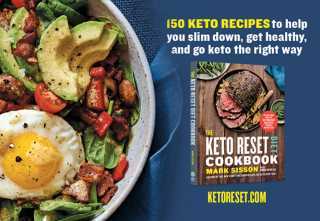 The Keto Reset Diet Cookbook is here! Well, almost here, but my team and I are excited to release it to the world—and especially to you, the readers of Mark’s Daily Apple. In fact, I decided to do a sneak peek today just so you’ll be the first to know.
The Keto Reset Diet Cookbook is here! Well, almost here, but my team and I are excited to release it to the world—and especially to you, the readers of Mark’s Daily Apple. In fact, I decided to do a sneak peek today just so you’ll be the first to know.
When I published my New York Times bestseller The Keto Reset Diet in October, 2017, keto was already hot among forward-thinking folks in the health, fitness, and longevity spheres, and it was catching on in the general population as well. Over the past year, its popularity has only continued to skyrocket. While I’ve personally enjoyed watching the tide of people rejecting carbohydrate dependency eating patterns and embracing a new scope of Primal/paleo/low-carb eating strategies, I also recognize the pitfalls within the potential….
On the one hand, the keto fervor has spurred people to question conventional nutrition advice, probably more than I’ve ever witnessed in my more-than-a-decade of conventional wisdom busting. That’s a good thing! On the other hand, as I’ve written before, the explosive growth has led to rampant hype, misinterpretation, and criticism. Even devoted keto enthusiasts have tweaked the foundational message to make keto a fat fest. A friend related to me recently how she’d attended a luncheon where one guest whipped out a stick of butter and set about applying pat after pat to her meal. You see, she was doing the keto diet!
I wrote The Keto Reset Diet as a countermeasure to the nutrient-poor, scientifically questionable, hacky versions of keto. I wanted to advance a version of keto that emphasizes the consumption of colorful, nutritious foods, including ample (but sensible) added fats when called for. I also wanted to put in a plug for fasting, eating in a compressed time window, and engaging in supportive behaviors like getting sufficient sleep and managing stress. In other words, the Primal interpretation and application of a ketogenic diet.
With this book project, I’d like to make another plug for enjoying the heck out of every single bite of food that you eat. This is pretty much my mission statement for my PRIMAL KITCHEN® product line—to enhance meals with healthy and deliciously flavored condiments—and it’s how I live my own life each day. Unfortunately, I’ve seen many keto enthusiasts resort to a somber, strict approach where bland meals are the norm to simplify counting and micromanaging macros. After all, if they keep their meals totally austere, they don’t have to stress about pesky carbs sneaking in and kicking them out of ketosis.
If you’ve read The Keto Reset Diet or taken the Keto Reset Online Mastery Course, you know that I don’t endorse any amount of struggling or suffering when eating a keto profile, just as I reject them in the context of a Primal diet. You probably also know that I refuse to eat anything that doesn’t bring me genuine pleasure. I want the same for you. That’s why I’m doing the work with you—helping you to eat colorful, flavorful, interesting food and stay within your ketogenic macros. This cookbook is part of that mission. Check out the video intro, and see what I mean.
?
The Keto Reset Diet Cookbook contains 150 keto-friendly and totally Primal-approved recipes. My co-author, Lindsay Taylor, Ph.D. and I have put together a collection that is sure to please every palate. (Yes, even your kids’—can you say Green Eggs and Ham?) We’re offering everything from quick-and-easy convenience foods (Handheld Chef Salad or Smoked Salmon Stacks) to recipes for nights when you feel like making something a little more special (Crab-stuffed Fish Pinwheels or Lamb Roast with Mint Chimichurri), and even some delectable desserts like the heavenly Dark Chocolate Pudding. Throwing a dinner party and want some keto-friendly fare that all your guests will love? We’ve got you covered! How about Bacon Party Mix, Roast Beef Bites with Horseradish Sauce, and Harissa Almond Dip?
In additional to the fabulous recipes, The Keto Reset Cookbook contains a plethora of educational content to explain the whats, whys, and hows of keto. Let’s just say, hypothetically, you give out copies of this cookbook as holiday gifts to your keto-curious friends and family. In addition to being inspired by the mouthwatering recipes, they’ll gain a good understanding of how to go keto the right way—laying the groundwork of ditching carb dependency and becoming somewhat fat-adapted before attempting a distinct keto phase, and steering clear of the flawed practices such as stuffing one’s face with fat in the name of making ketones.
The fact is, I recognize that a cookbook can be a less intimidating way to enter the keto scene. With The Keto Reset Diet Cookbook, not only will you get the basic guidelines you need to do it right, you’ll have an awesome collection of recipes to keep things lively and creative. Here are two of my favorites….
Crab Salad Remoulade
Ingredients:
1/2 cup avocado oil mayo
2 Tablespoons Dijon mustard (whole-grain recommended)
1/2 teaspoon prepared horseradish
1/2 teaspoon Cajun Seasoning
1/2 teaspoon sweet paprika
1/4 teaspoon garlic powder
1/8 teaspoon cayenne pepper (optional)
1 teaspoon fresh lemon juice
1 pound lump crabmeat
1 stalk celery with leaves, finely chopped
2 scallions, finely chopped
8 cups arugula
2 avocados, sliced
1 lemon, cut into wedgesInstructions:
In a bowl, combine the mayo, mustard, horseradish, Cajun seasoning, paprika, garlic powder, cayenne, and lemon juice. Add the crabmeat, celery, and scallions. Stir well to combine.
(Optional: Refrigerate the salad to chill.)
To serve, place 2 cups arugula on each salad plate. Arrange 1/2 sliced avocado on top. Scoop one-quarter of the salad mixture on top of the avocado. Serve with a lemon wedge.
Nutritional Information (per serving):
Calories: 293; Carbohydrate: 10 grams; Fat: 26 grams; Protein: 9 grams
Kale Salad With Pumpkin Croutons
Ingredients:
½ cup Homemade Pumpkin Puree (page 245) or unsweetened canned
1 small bunch curly kale (green or red), ribs and leaves separated
1 Tablespoon extra-virgin olive oil
1 teaspoon fresh lemon juice
½ teaspoon kosher salt
1 small bunch Swiss chard, ribs and leaves separated
4 Tablespoons keto-friendly dressing of choice
¼ teaspoon Pumpkin Pie Spice Blend (page 254)
2 Tablespoons coconut oil
½ cup crumbled goat cheese
3 Tablespoons pumpkin seeds or sunflower seeds
½ cup raspberries or blackberries (optional)Instructions:
If you are using homemade pumpkin puree, line a sieve with a clean kitchen towel and place it over a bowl. Scoop the pumpkin puree into the towel and set aside. You can skip this step if you are using canned pumpkin, or if your homemade pumpkin is not too watery.
Tear or cut the kale leaves into roughly bite-size pieces and place them in a large bowl. Add the olive oil, lemon juice, and ¼ teaspoon of the salt. Use your hands to knead (massage) the kale for about 2 minutes, until the volume has reduced by half.
Chop the Swiss chard leaves into small pieces and mix it into the kale. Pour in 2 tablespoons of the dressing and stir well. Set aside.
Place the pumpkin in a small bowl. Stir in the pumpkin pie spice and remaining ¼ teaspoon salt. In a skillet, heat the coconut oil over medium heat for 2 minutes. When it is hot, carefully drop rounded teaspoons of the pumpkin mixture into the oil (watch for splatter) and press down to flatten slightly. Work in batches to avoid crowding the pan. Cook until browned on the first side, about 2 minutes. Flip and cook 2 minutes on the second side. Remove the pumpkin “croutons” to a plate and repeat until you have used all the pumpkin mixture. Add more oil if the pan gets too dry.
Dice the chard and kale ribs. Add them to the skillet and stir-fry for about 4 minutes. Mix them into the salad.
Transfer the kale and chard mixture to a serving bowl. Crumble the goat cheese over the top, then sprinkle on the pumpkin seeds. Arrange the berries (if using) and the pumpkin “croutons” on top. Drizzle with the remaining 2 tablespoons dressing. Serve immediately.
Nutritional Information (per serving):
Calories: 396; Carbohydrate: 13 grams; Fat: 33 grams; Protein: 14 grams
A Mark’s Daily Apple Deal—Enjoy 4 Bonus Items!
I know that members of our Primal community at Mark’s Daily Apple and in the Keto Reset Facebook Group have come to expect delicious recipes from the MDA and Primal Kitchen teams, and I’m confident this cookbook won’t disappoint. I’m so excited for you to see it, I’m offering a bonus deal you won’t want to miss!
Pre-order your copy of The Keto Reset Diet Cookbook from your favorite retailer, and simply submit your receipt (on the The Keto Reset Cookbook webpage—under “Claim Your Bonus Items”) to receive access to these four gifts:

$10 Discount Code: You’ll receive a $10 discount off the Primal Kitchen line of keto-approved healthy salad dressings and mayonnaise at PrimalBlueprint.com (minimum order $20).
Recipe Video: Join co-author Lindsay Taylor, Ph.D. in her kitchen as she whips up one of her favorite recipes: blistered shishito peppers with the world’s easiest dipping sauce. (Yes, the recipe is in the book.)
Recipe Sampler PDF: Enjoy a collection of the best finger food recipes from the library of Keto Reset books, with a couple new recipes included for good measure. Perfect for keto-friendly party platters, snacks, and lunch boxes!
Audiobook Excerpt: Listen and learn more from a sample of the audiobook of the New York Times bestseller The Keto Reset Diet narrated by dynamic co-author Brad Kearns.
Folks, I’m thrilled to announce this cookbook here on Mark’s Daily Apple where the entire Primal journey began. Speaking of which…if you consider yourself Primal but haven’t felt moved to go keto, no matter. I think you’ll enjoy these recipes just as much as any keto diehard. Every recipe is 100% Primal and Grok-approved. (And on that note, look for more thoughts on the Primal-Keto connection in tomorrow’s feature.)
For now, thank you, everyone, for your support over the years and for being here today. I can’t wait to hear what you think of The Keto Reset Diet Cookbook.
The post Introducing The Keto Reset Diet Cookbook (Plus, an MDA Pre-Order Bonus Deal) appeared first on Mark's Daily Apple.



Mark Sisson's Blog
- Mark Sisson's profile
- 199 followers



